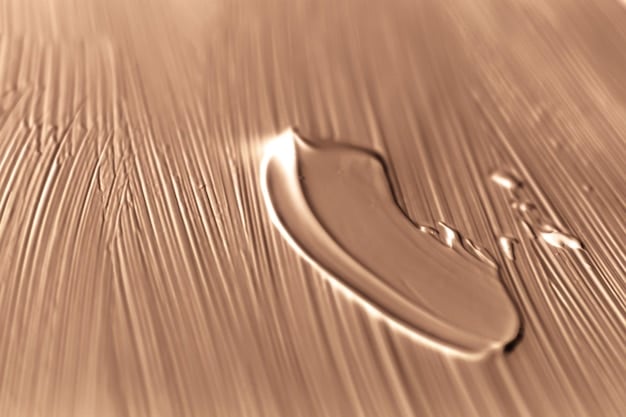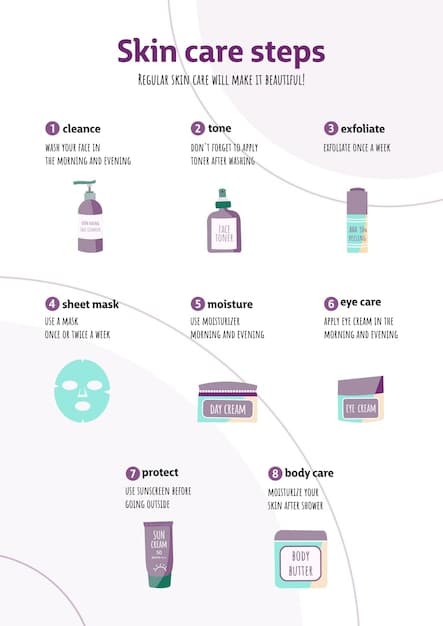The Complete Guide to Layering Skincare Products for Maximum Effectiveness

Layering skincare products effectively involves applying them in a specific order—typically from lightest to thickest consistency—to ensure each product absorbs properly and delivers its intended benefits.
Achieving radiant and healthy skin isn’t just about having the right products; it’s about using them in the right order. This complete guide to layering skincare products for maximum effectiveness will walk you through the optimal sequence to ensure you’re getting the most out of your skincare routine.
Understanding Skincare Layering: Why It Matters
Layering skincare products is more than just applying them one after another. It’s a strategic approach to skincare that maximizes the absorption and efficacy of each product. When done correctly, layering can significantly improve your skin’s health and appearance. When you layer the correct way, you’re setting yourself up for success.
The Science Behind Layering
The order in which you apply your skincare products matters because different products have different molecular weights and formulations. Lighter, water-based products need to be applied first to penetrate the skin effectively. Heavier, oil-based products should be applied last to lock in moisture and create a protective barrier.
Benefits of Correct Layering
Proper layering ensures that each product can penetrate the skin and deliver its intended benefits. It prevents products from blocking each other, maximizes hydration, and enhances the overall effectiveness of your skincare routine. Some of these products help boost your skins immunity to certain weather and seasonal changes.
- Enhanced product absorption
- Improved hydration levels
- Increased efficacy of active ingredients
- Protection against environmental stressors
Understanding the science and benefits behind layering sets the foundation for a successful skincare routine. By following the correct order, you can unlock the full potential of your products and achieve healthier, more radiant skin.

The Golden Rule: Thin to Thick
The general rule of thumb for layering skincare products is to apply them from thinnest to thickest consistency. This ensures that each product can be properly absorbed into the skin without being blocked by heavier formulations. Always be sure to give yourself plenty of time.
Why Thin to Thick Works
Applying thinner products first allows them to penetrate the skin more easily. If you were to apply a thick cream first, it would create a barrier that prevents lighter products from being absorbed properly. This method helps prevent you from wasting more material or even money.
Exceptions to the Rule
While the thin-to-thick rule is a good guideline, there are some exceptions. For example, sunscreen should always be applied as the last step in your morning routine, regardless of its consistency. Understanding these nuances is key to optimizing your skincare layering process.
- Sunscreen: Always the last step in the morning
- Facial oils: Can be applied last at night to seal in moisture
- Specific treatments: Follow product instructions for the best results
By adhering to the thin-to-thick rule, with a few exceptions, you can ensure that your skincare products are working effectively to nourish and protect your skin. This also keeps things from being more difficult for you than necessary.
The Ultimate Skincare Layering Order
Now, let’s dive into the specific order you should follow when layering your skincare products. This step-by-step guide will cover both morning and evening routines, ensuring that your skin receives the right care at the right time. It takes some patience and discipline.
Morning Skincare Routine
Your morning routine should focus on protecting your skin from environmental stressors and preparing it for the day. Here’s the recommended order:
- Cleanser: Start with a gentle cleanser to remove any impurities or oil that accumulated overnight.
- Toner: Apply a toner to balance your skin’s pH levels and prepare it for the next steps.
- Serum: Use a serum with antioxidants like vitamin C to protect against free radical damage.
- Moisturizer: Hydrate your skin with a lightweight moisturizer.
- Sunscreen: Finish with a broad-spectrum sunscreen with an SPF of 30 or higher.
Evening Skincare Routine
Your evening routine should focus on cleansing, repairing, and hydrating your skin. Here’s the recommended order:
- Makeup Remover: If you wear makeup, start with a makeup remover to thoroughly cleanse your skin.
- Cleanser: Use a cleanser to remove any remaining impurities.
- Exfoliant (1-2 times a week): Use a chemical exfoliant to remove dead skin cells.
- Toner: Apply a toner to balance your skin’s pH levels.
- Serum: Use a serum with active ingredients like retinol or hyaluronic acid to target specific concerns.
- Moisturizer: Apply a rich moisturizer to hydrate your skin overnight.
- Facial Oil (Optional): Seal in moisture with a facial oil.

Ingredient Considerations: What to Layer and What to Avoid
Certain skincare ingredients work well together and can enhance each other’s benefits, while others can cause irritation or reduce efficacy when layered incorrectly. Knowing which ingredients to combine and which to avoid is crucial for a safe and effective skincare routine. It’s key to research this on your own.
Ingredients That Work Well Together
Some ingredient pairings can create a synergistic effect, boosting the overall effectiveness of your skincare routine. For example, vitamin C and sunscreen provide enhanced protection against sun damage. Hyaluronic acid and moisturizer work together to draw moisture into the skin and lock it in place.
Ingredients to Avoid Layering
Certain ingredients can react negatively when layered, leading to irritation, redness, or reduced efficacy. For example, combining retinol with AHAs/BHAs can cause excessive dryness and irritation. It’s important to be mindful of these potential interactions and adjust your routine accordingly. It will be worth it.
- Vitamin C and Niacinamide: Can cause redness and irritation
- Retinol and AHAs/BHAs: Can lead to excessive dryness and peeling
- Benzoyl Peroxide and Retinol: Can deactivate each other
Understanding ingredient interactions can help you create a more effective and gentle skincare routine. Always research new product combinations and consider patch-testing to avoid adverse reactions. This will help you stay alert to the most serious problems of skincare.
Personalizing Your Skincare Layering Routine
While there are general guidelines for layering skincare products, the best routine is one that’s tailored to your individual skin type and concerns. Every skin is different and that should be noted.
Identifying Your Skin Type
Understanding your skin type is the first step in creating a personalized skincare routine. Whether you have dry, oily, combination, or sensitive skin, choosing products that cater to your specific needs is essential.
Addressing Specific Skin Concerns
Consider any specific skin concerns you want to address, such as acne, aging, hyperpigmentation, or sensitivity. Look for products with active ingredients that target these concerns and incorporate them into your routine accordingly. A big part of skincare is knowing your own problem areas.
Key Steps to Personalization:
- Assess your skin type
- Identify your primary skin concerns
- Research products with targeted ingredients
- Monitor your skin’s reaction to new products
Personalizing your skincare layering routine ensures that you’re providing your skin with the specific care it needs to thrive. Be patient, experiment with different products and combinations, and adjust your routine as needed to achieve your skincare goals.
Common Mistakes to Avoid When Layering Skincare
Even with the best intentions, it’s easy to make mistakes when layering skincare products. Knowing what to avoid can help you optimize your routine and prevent common issues such as irritation, breakouts, or reduced product efficacy. If you skip important steps, you won’t get the results you desire.
Overloading Your Skin
Applying too many products at once can overwhelm your skin, leading to clogged pores, breakouts, and irritation. Stick to a streamlined routine with essential products and avoid layering unnecessary steps.
Not Allowing Products to Absorb
Rushing through your skincare routine and not allowing products to fully absorb can prevent them from working effectively. Wait a few minutes between each layer to give your skin time to soak up the product. Here’s a common list of mistakes to avoid.
- Applying too many products
- Not waiting for absorption
- Using incompatible ingredients
- Ignoring your skin’s reaction
By avoiding these common mistakes, you can ensure that your skincare layering routine is both effective and gentle on your skin. Pay attention to your skin’s needs, research new products thoroughly, and adjust your routine as needed to maintain a healthy, radiant complexion.
| Key Point | Brief Description |
|---|---|
| 💧 Thin to Thick | Apply products from lightest to heaviest consistency. |
| ☀️ Sunscreen Last | Always apply sunscreen as the final step in your morning routine. |
| 🧪 Ingredient Compatibility | Avoid layering retinol with AHAs/BHAs to prevent irritation. |
| 🕰️ Absorption Time | Allow products to fully absorb before applying the next layer. |
Frequently Asked Questions (FAQ)
▼
The general rule is to apply products from thinnest to thickest consistency. A typical routine starts with cleanser, toner, serum, moisturizer, and ends with sunscreen in the morning.
▼
Not necessarily. Morning routines should focus on protection, while evening routines should prioritize cleansing and repair. Adjust the products based on those needs.
▼
It’s best to wait a few minutes between each layer to allow the product to fully absorb. This ensures maximum effectiveness and prevents products from mixing improperly.
▼
Avoid layering retinol with AHAs/BHAs, as this can cause excessive dryness and irritation. Also, vitamin C and niacinamide can sometimes cause redness when combined.
▼
If your skin feels hydrated, looks radiant, and doesn’t experience irritation, you’re likely layering correctly. Pay attention to how your skin responds and adjust your routine as needed.
Conclusion
Mastering the art of layering skincare products can significantly enhance your skin’s health and appearance. By following the guidelines in this guide and personalizing your routine to meet your specific needs, you can unlock the full potential of your skincare products and achieve a radiant, healthy complexion.





